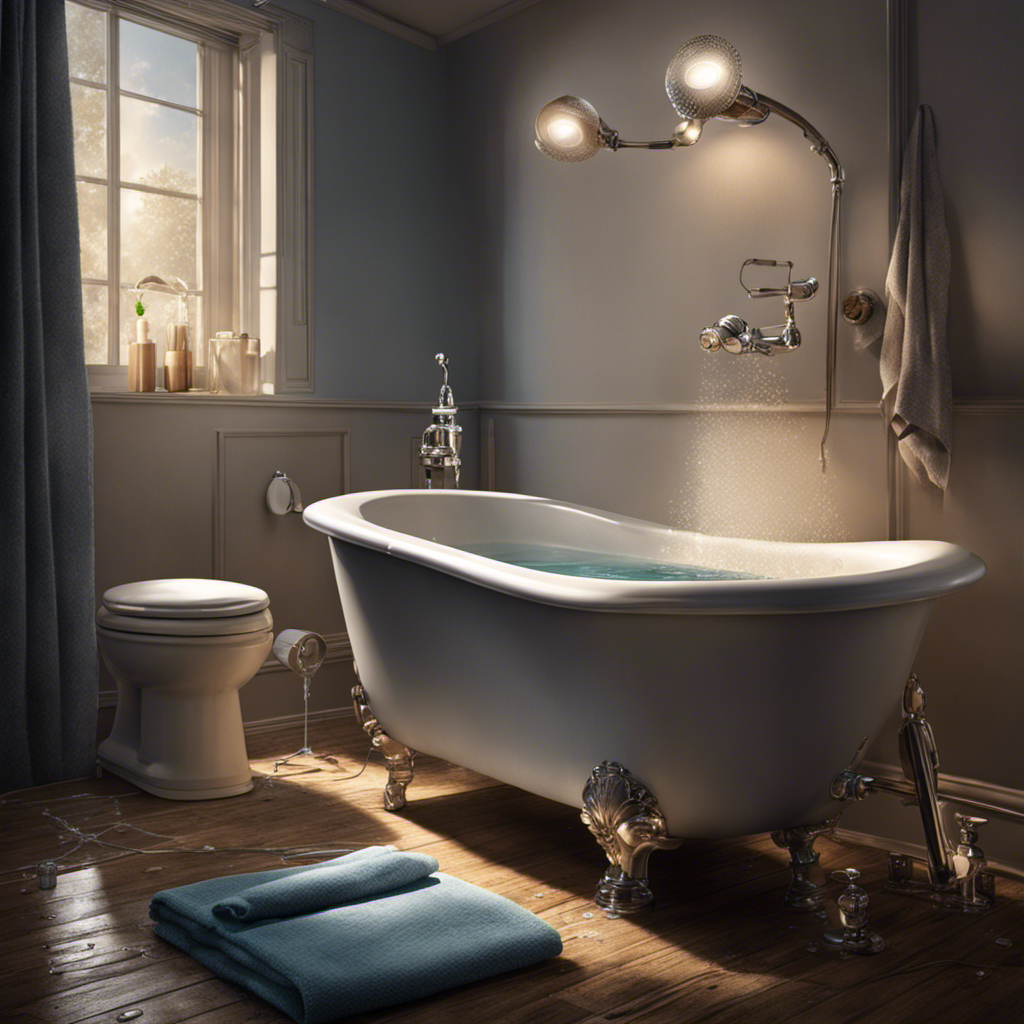Did you know that a non-flushing toilet is one of the most common plumbing problems homeowners face? If you’ve ever found yourself in this frustrating situation, don’t worry – I’ve got you covered.
In this article, I will guide you through step-by-step troubleshooting and provide DIY fixes for a clogged toilet. I’ll also let you know when it’s time to call a professional plumber and share preventive measures to avoid future toilet issues.
Let’s get your toilet flushing smoothly again!
Key Takeaways
- Check for visible blockages in the toilet bowl.
- Use a plunger or a mixture of hot water and dish soap to unclog the toilet.
- Consider calling a professional plumber for persistent or severe clogs.
- Practice preventive measures such as regular maintenance and avoiding flushing non-flushable items to prevent future toilet issues.
Common Causes of a Non-Flushing Toilet
One of the most common causes of a non-flushing toilet is a clogged pipe. When the toilet bowl is filled with water but fails to flush, it indicates that there is an obstruction in the pipe preventing proper water flow. This can happen due to various reasons, such as excessive toilet paper, foreign objects, or a build-up of waste over time.
When a pipe is clogged, the water level in the toilet bowl may rise or remain stagnant. It is important not to flush repeatedly as this may cause the water to overflow. Instead, it is advisable to use a plunger or a toilet auger to remove the blockage and restore proper flushing functionality.
Step-by-Step Troubleshooting Guide
Start by checking if there’s any visible blockage in the toilet bowl. Before diving into toilet tank maintenance and troubleshooting flushing mechanisms, it’s important to rule out any obvious obstructions. Look for items such as toilet paper, foreign objects, or excessive waste that may be preventing a proper flush. If there’s no visible blockage, it’s time to move on to the next step.
Toilet tank maintenance is crucial for ensuring a smooth flushing experience. Check the water level in the tank to ensure it’s at the correct level, adjust the float if necessary. Also, inspect the flapper valve for any damage or wear.
Troubleshooting flushing mechanisms involves checking the chain, handle, and flush valve. By following these steps, you can identify and potentially resolve the issue with your non-flushing toilet.
Now, let’s move on to DIY fixes for a clogged toilet.
DIY Fixes for a Clogged Toilet
To fix a clogged toilet, you can try using a plunger or a mixture of hot water and dish soap.
When a toilet becomes clogged, it is important to address the issue promptly to avoid further damage.
First, grab a plunger and place it over the drain hole in the bottom of the toilet bowl. Apply downward pressure and create a seal before vigorously plunging up and down several times.
If this doesn’t work, try pouring a mixture of hot water and dish soap into the toilet bowl. Let it sit for a few minutes to break down the clog, then flush the toilet to see if the clog has cleared.
Regular toilet maintenance, such as avoiding flushing excessive amounts of toilet paper or foreign objects, can help prevent future clogs.
When to Call a Professional Plumber
If you’re experiencing a persistent clog, it might be time to consider calling a professional plumber. While there are many DIY fixes for minor plumbing issues, there are certain signs that indicate a serious problem that requires professional attention.
One of the main factors to consider when deciding whether to DIY or hire a professional is the severity of the issue. If you’ve tried multiple DIY methods and the problem persists, it’s best to leave it to the experts.
Additionally, if you notice signs such as recurring clogs, slow drains, or foul odors, it’s a clear indication of a serious plumbing issue that requires professional intervention. Ignoring these signs can lead to further damage and costly repairs down the line.
When in doubt, it’s always better to be safe than sorry and call a professional plumber.
Preventive Measures to Avoid Future Toilet Issues
When it comes to preventing future toilet issues, you should make sure to regularly maintain your plumbing system by scheduling routine inspections and cleanings. This will help identify any potential problems before they become major issues, saving you time and money in the long run. In addition to regular maintenance, there are some simple tips you can follow to keep your toilet running smoothly. First, avoid flushing anything other than toilet paper down the toilet. Items like paper towels, sanitary products, and baby wipes can cause clogs. Second, be mindful of what you put down your drains. Grease, oil, and food particles can build up over time and lead to blockages. Finally, if you find yourself without a plunger, there are alternative methods for unclogging a toilet. One method involves using dish soap and hot water to break up the clog. Another method is using a wire hanger to manually remove the blockage. By following these tips and taking proactive measures, you can prevent future toilet issues and ensure a smoothly running plumbing system.
| Column 1 | Column 2 | Column 3 |
|---|---|---|
| Regular maintenance | Avoid flushing | Be mindful of what |
| inspections and | non-flushable items | you put down drains |
| cleanings | ||
| Use dish soap and hot | Use a wire hanger | |
| water to break up | to manually remove | |
| clogs | blockages | |
Frequently Asked Questions
How Often Should I Clean My Toilet to Prevent Future Flushing Issues?
I clean my toilet regularly to prevent future flushing issues. It’s important to keep the toilet clean to avoid clogs and ensure proper functionality. Look out for signs of a clogged toilet and use toilet cleaning hacks to maintain its performance.
Are There Any Specific Toilet Paper Brands That Are More Likely to Cause Clogs?
When it comes to toilet paper brands, some may be more likely to cause clogs than others. However, there are toilet paper alternatives available. In terms of unclogging toilets, there are best practices to follow.
Can Flushing Non-Flushable Items Down the Toilet Cause Long-Term Damage?
Flushing non-flushable items can have serious plumbing consequences and cause long-term damage to your toilet. It can also have an environmental impact by clogging sewers and polluting water sources.
Does the Age of My Toilet Affect Its Flushing Performance?
The age of a toilet can impact its flushing performance. Over time, the toilet flushing mechanisms may wear down, leading to weaker flushes or clogs. Signs of a failing toilet include frequent backups and inadequate flushing.
Is It Normal for My Toilet to Occasionally Have Weak Flushes?
Yes, it is normal for a toilet to occasionally have weak flushes. This can be caused by various factors such as a faulty toilet flushing mechanism or common toilet flushing problems.
Conclusion
In conclusion, when faced with a non-flushing toilet, it is crucial to identify the root cause of the problem. By following the step-by-step troubleshooting guide and attempting the DIY fixes, one can often resolve the issue without the need for a professional plumber.
However, if all else fails, it is wise to call in an expert to avoid further damage. Remember, taking preventive measures such as regular maintenance and being mindful of what is flushed can help prevent future toilet issues.
With a little knowledge and some handy tips, you can keep your toilet running smoothly.










